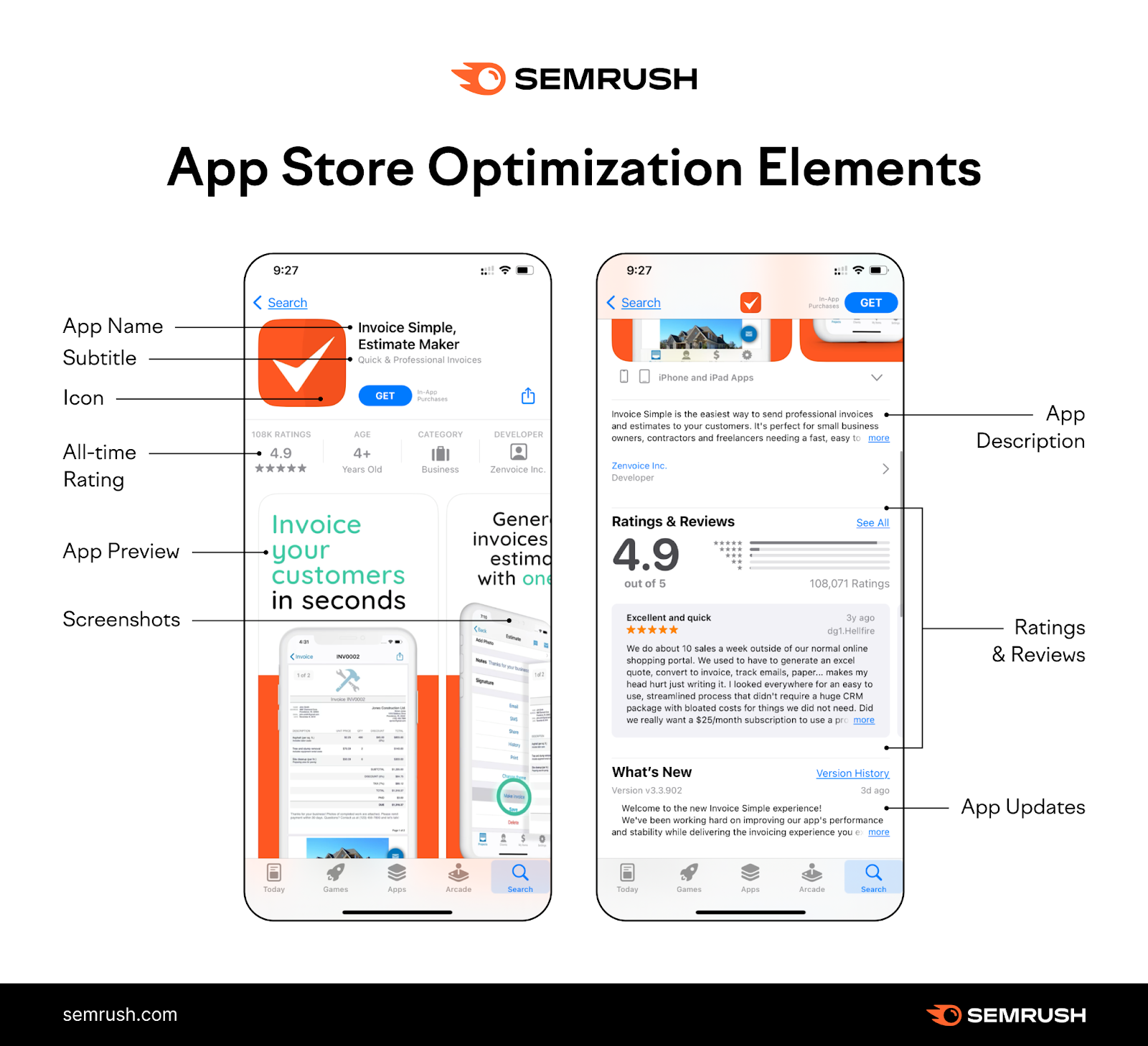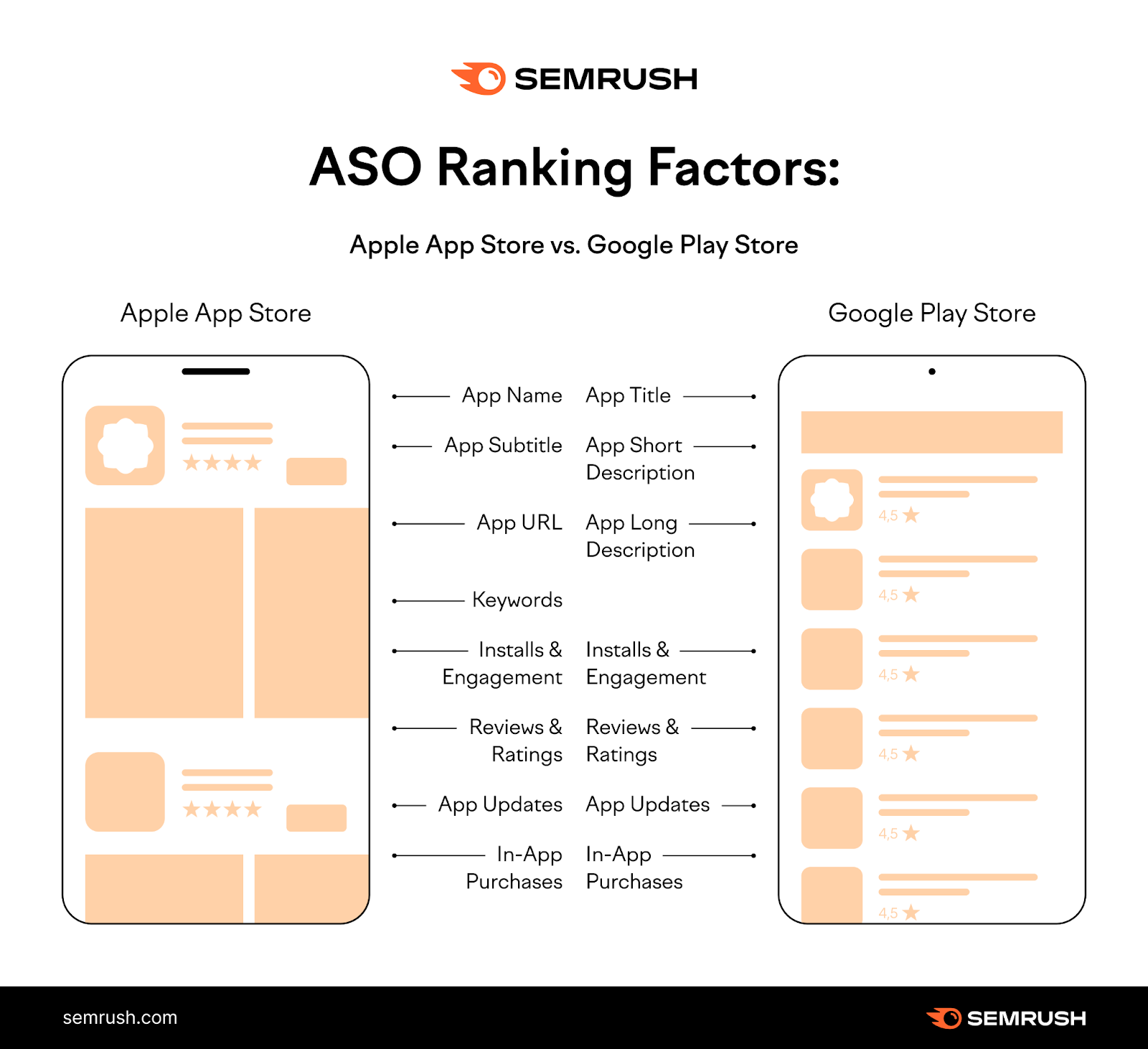In today’s digital landscape, where mobile applications dominate the tech sphere, developers are constantly striving to make their apps stand out in a sea of competition. With millions of apps vying for attention across various app stores, simply creating a great app is no longer sufficient; it needs to be discovered by users. This is where the concept of App Store Optimization (ASO) comes into play.
What is App Store Optimization (ASO)?
App Store Optimization (ASO) is the process of enhancing the visibility and discoverability of a mobile application within the app store ecosystem. Much like Search Engine Optimization (SEO) for websites, ASO aims to improve an app’s ranking in app store search results, thereby increasing its chances of being found and downloaded by users. It encompasses a range of strategies and techniques aimed at optimizing various elements of an app’s store listing to maximize its organic (unpaid) traffic and user engagement.
Key Components of ASO: A Deep Dive
- App Title: The app title serves as the first point of contact between users and the app. It should be concise, descriptive, and contain relevant keywords that align with the app’s core features and target audience. A well-crafted title not only improves visibility but also enhances brand recognition and recall.
- Keywords: Keywords play a pivotal role in ASO, acting as the bridge between user intent and app discovery. Thorough keyword research is essential to identify relevant terms and phrases that users are likely to search for. These keywords should be strategically incorporated into the app’s title, description, and metadata to improve its visibility in app store search results.
- App Description: The app description serves as a marketing pitch, offering users a glimpse into the app’s features, functionality, and value proposition. It should be engaging, and informative, and highlight the unique selling points of the app. Incorporating relevant keywords naturally within the description can further enhance its visibility and relevance to users.
- Icon and Screenshots: Visual elements such as the app icon and screenshots play a crucial role in capturing users’ attention and conveying the essence of the app. The app icon should be visually appealing, recognizable, and reflective of the app’s brand identity. High-quality screenshots showcasing the app’s interface, features, and user experience can help users visualize the app’s value and increase conversion rates.
- App Ratings and Reviews: User ratings and reviews serve as social proof of an app’s quality and credibility. Positive ratings and reviews not only influence user perception but also impact its ranking in app store search results. Encouraging satisfied users to leave feedback and promptly addressing any issues or concerns raised by users can help maintain a positive reputation and drive more downloads.
- App Updates: Regularly updating the app with new features, enhancements, and bug fixes is essential for maintaining user engagement and satisfaction. It signals to app store algorithms that the app is active, relevant, and deserving of higher visibility. Keeping the app content fresh and responding to user feedback can further improve its ASO performance over time.
Why You Need App Store Optimization (ASO)
In the bustling digital world of mobile applications, where millions of apps compete for users’ attention, the importance of App Store Optimization (ASO) cannot be overstated. ASO isn’t just a nice-to-have; it’s a strategic imperative for app developers looking to succeed in today’s competitive marketplace. Let’s explore why ASO is essential for the success of your app.
- Enhancing Visibility and Discoverability
In a crowded app store environment, simply launching an app isn’t enough to ensure its success. Without proper optimization, your app risks getting lost among the plethora of options available to users. ASO is the key to improving your app’s visibility and discoverability in app store search results, making it easier for users to find and download your app. - Driving Organic Traffic
User acquisition costs continue to rise, making it increasingly challenging for developers to acquire new users through paid advertising alone. ASO offers a cost-effective solution by driving organic (unpaid) traffic to your app’s store listing. By optimizing your app’s metadata, including titles, keywords, and descriptions, you can attract users who are actively searching for apps like yours, resulting in higher conversion rates and increased downloads. - Improving User Acquisition and Retention
Acquiring new users is important, but retaining them is equally—if not more—crucial for long-term success. ASO helps in both aspects by not only attracting users to download your app but also enticing them to engage with it. By effectively communicating your app’s value proposition through compelling descriptions and engaging visuals, you can increase user satisfaction and retention rates, leading to sustained success over time. - Staying Competitive in the App Ecosystem
The app marketplace is highly competitive, with new apps entering the scene every day. To stand out amidst the competition, you need to stay ahead of the curve with proactive ASO strategies. By monitoring market trends, analyzing competitor strategies, and continuously optimizing your app listing, you can maintain a competitive edge and ensure your app remains visible and relevant to users. - Maximizing App Revenue
For many developers, generating revenue is a primary objective. ASO plays a crucial role in maximizing app revenue by driving downloads, increasing user engagement, and optimizing monetization opportunities within the app. By attracting high-quality users who are genuinely interested in your app’s offerings, you can enhance revenue streams and unlock the full potential of your app’s monetization strategies.
Measuring ASO Success: Analyzing Key Metrics
Tracking and analyzing key performance metrics is critical for evaluating the effectiveness of ASO efforts and optimizing strategies for maximum impact. App store analytics tools provide valuable insights into metrics such as app store impressions, app page views, downloads, and user retention rates. By monitoring these metrics regularly, developers can identify trends, patterns, and areas for improvement, enabling them to refine their ASO strategy and achieve sustainable growth.
Choose One Viral Media for unparalleled expertise in App Store Optimization (ASO). Our tailored strategies ensure maximum visibility and downloads for your app. With comprehensive optimization techniques, we fine-tune every aspect of your app’s presence. Backed by data-driven insights, we deliver measurable results and surpass expectations. Elevate your app’s success with One Viral Media’s proven ASO services.
Conclusion: Navigating the ASO Landscape
In conclusion, App Store Optimization (ASO) is a multifaceted discipline that encompasses various strategies and techniques aimed at improving an app’s visibility, discoverability, and ultimately, its success in the competitive app marketplace. By optimizing key elements within the app store listing and implementing effective ASO strategies, developers can enhance their app’s chances of being discovered by users and drive more downloads. However, ASO is not a one-time endeavor; it requires ongoing monitoring, analysis, and adaptation to stay ahead of the curve in the ever-evolving app ecosystem. With a thorough understanding of ASO principles and a data-driven approach, developers can unlock the full potential of their apps and achieve sustainable growth in the dynamic world of mobile app marketing.
FAQs about App Store Optimization (ASO)
1. What is App Store Optimization (ASO)? App Store Optimization (ASO) is the process of improving the visibility and discoverability of a mobile application in the app store’s search results. Similar to SEO for websites, ASO involves optimizing various elements within an app’s store listing to increase its chances of being found and downloaded by users.
2. Why is ASO important for mobile apps? ASO is crucial for mobile apps because it helps them stand out in a crowded marketplace. With millions of apps available across various platforms, ASO ensures that your app gets noticed by potential users, resulting in increased downloads and user engagement.
3. What are the key components of ASO? The key components of ASO include app title, keywords, app description, icon and screenshots, app ratings and reviews, and app updates. Optimizing these elements can significantly improve an app’s visibility and attractiveness to users.
4. How do keywords impact ASO? Keywords play a crucial role in ASO as they determine how well an app ranks in app store search results. By identifying and strategically incorporating relevant keywords into an app’s metadata, developers can increase its visibility to users searching for similar apps or content.
5. What are the benefits of ASO? The benefits of ASO include increased visibility and discoverability, higher app store rankings, more organic (unpaid) traffic, improved user acquisition and retention, enhanced user engagement, and ultimately, higher app downloads and revenue.
6. How often should ASO be updated? ASO is an ongoing process that requires regular monitoring and updates. App store algorithms and user behavior can change over time, so it’s essential to stay proactive and adapt your ASO strategy accordingly. Regularly updating keywords, optimizing app listings, and responding to user feedback can help maintain and improve ASO performance.
7. How can I measure the success of my ASO efforts? Success in ASO can be measured through various key performance indicators (KPIs) such as app store rankings, app store impressions, app page views, downloads, conversion rates, user ratings and reviews, and user retention rates. By tracking and analyzing these metrics, developers can evaluate the effectiveness of their ASO strategy and make informed optimizations.
8. Can I use ASO for both the Apple App Store and Google Play Store? Yes, ASO techniques can be applied to both the Apple App Store and Google Play Store. While there may be some differences in optimization strategies due to platform-specific guidelines and algorithms, the core principles of ASO remain the same across both app stores.
9. Are there any tools available to help with ASO? Yes, there are numerous ASO tools and platforms available to assist developers in optimizing their app listings. These tools provide features such as keyword research, app store analytics, competitor analysis, and performance tracking, making it easier to identify optimization opportunities and measure ASO success.
10. Is ASO a one-time effort, or does it require ongoing maintenance? ASO is not a one-time effort but an ongoing process that requires continuous monitoring and optimization. App store algorithms, user behavior, and market trends can change over time, so it’s essential to regularly update and refine your ASO strategy to maintain and improve your app’s visibility and performance in the app stores.



